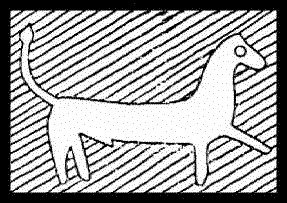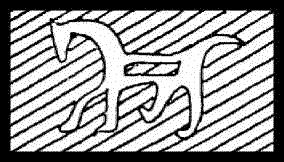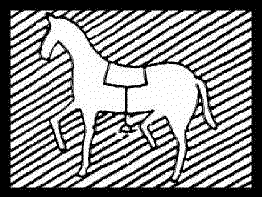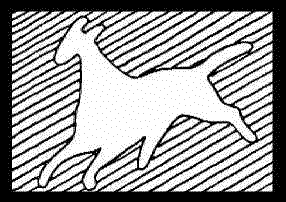
Pagans visiting the chalk downs of southern England will be more than familiar with the white horses of various ages which dot the landscape. The earliest surviving one is of course the most famous the White Horse of Uffington; the majority date from the 18th and early 19th centuries and are very stylised and sterile by comparison. It is not widely known, however, that Warwickshire once had its own horse carved into the landscape and a truly unique beast it was - the Red Horse of Tysoe, the site of which lies on the A422 between Banbury and Stratford upon Avon not a few miles from the site of the battle of Edgehill.
By the standards of hill figures around the country, this was
an early example. The first mention of it appears in 1607, before the explosion of
interest in "antiquities" which developed later that century and has continued
ever since. At that date it was described thus: "Of the redy soil here comes the
names of Rodway and Rodley; yea, and a great part of the very Vale is thereupon termed the
vale of Red Horse, of the shape of a horse cut out in a red hill by the country people
hard by Pillerton." 
Some years later, Sir William Dugdale, who had fought at the Battle of Edgehill, was given the task of recording features of interest around the country in case the Parliamentarians should seek to destroy them. Dugdale wrote: "Within the precinct of the Mannour of Tishoe now belonging to the Earl of Northampton .... there is cut upon the side of Edgehill the proportion of a Horse in a very large forme; which by reason of the ruddy colour of the earth is called the Red Horse, and giveth denomination to that fruitful and pleasant country thereabouts, commonly called the Vale of the Red Horse: the trenches of which ground where the shape of the said Horse is so cut out, being yearly scoured by a Freeholder in this Lordship, who holds certain lands there by that service."
And Celia Feinnes, who travelled throughout England in the late 17th Century, records: "We went by Eshum (Evesham) and the Vale of the Red Horse, being a Vale of great extent, the earth is all red, its a very rich Country for corn and fruites and woodes; its called the Vale of Eshum or of the Red Horse from a red horse cut on some of the hills about it, and the Earth all looking red the horse lookes so as that of the white horse vale"
Much mystery surrounds the now lost Red Horse and not much is
known for certain. What is known is that it was red because it was cut into the red clay
soils of the scarp edge overlooking the site of the Battle of Edgehill. Although white
limestone does underlie the landscape at this point it is found many yards below the
surface and therefore too deep for the local people to have exploited to give the horse
the more familiar white outline. By contrast, most of the hill figures of typical
"white horse" country are cut into chalk barely a foot or so below the surface. 
Much of the evidence, accounts and descriptions for Tysoe's Red Horse found among the writings of various 18th and 19th century antiquarians is confused and even contradictory - mainly because there was a series of red horses over some considerable span of time. Sketches which were made of the horse at various times differ quite radically in their portrayal of the beast and it is not known for certain whether there was one figure which was allowed periodically to become overgrown and subsequently recut from time to time with a "evolving" outline or whether the horse was occasionally lost completely and recut from scratch; it seems certain however that there was only one such horse at a time as there have been no records of multiple horses on or around the site. Even a cursory glance at the various sketches made over the years which are reproduced here will show that it is inconceivable that the accounts could refer to a single hill figure. It is also clear that in its various incarnations the horse appeared on differing slopes in the same general area.
In fact it appears that there have been five Red Horses - three close together on the scarp edge some few hundred yards NE of Old Lodge Farm and the other two close together to the SW of Sun Rising House. The latter were the more recent ones, one dating from about 1800 and the other was still within living memory of local people some 30 years ago. Of the earlier three the first was by far the largest and is believed to have measured about 100 yards long by 70 yards high. The second, although smaller was still a significant beast, and overlapped the first slightly. The third was much smaller - only about 18 yards long.
The earliest account, Dugdale's, is the only one to comment on the size of the animal, suggesting that this earliest figure was the great 100 yard long beast referred to earlier. Celia Fiennes' account, dating from some 30 years later, makes no mention of the horse's size, so it has been concluded that the Great Horse, as it has been called, disappeared during those 30 or so years to be replaced by a smaller beast seen by Mrs Feinnes. Thereafter each succeeding Red Horse appears to have been smaller than its predecessor.
It should be remembered that most hill figures, not just the Red Horse of Tysoe, were cut only as deep as the overlying turf so that a few seasons' growth of grass and scrub would have encroached onto the figure so that it would probably have disappeared within a few years - a decade at most. At very best a few seasons' growth would have been sufficient to ensure that the outline of the hill figure would have become blurred and led to a gradual evolution in the shape even of a long-established one. A comparison of sketches of the White Horse of Uffington over a number of years in the 19th and early 20th centuries, for example, suggests that the shape of this beast changed quite radically in the course of fewer than 100 years. This presumably explains the importance given until the mid 19th century to the annual "scouring" of a hill figure by local people, often as part of "feudal" duties. Thomas Hardy recorded such an event in his novel The Scouring of the White Horse which tells of the festivities surrounding the scouring of the Uffington White Horse in the 1850s.
During the 18th century there were a number of squabbles between various antiquarians (strangely, many of them Church of England clergy) about the purpose or meaning of the horse. The Reverends Wise and Asplin, for example, bickered over Wise's theory that the horse had been cut to commemorate the Earl of Warwick's slaughter of his horse at the Battle of Towton in 1461 - regarded as a crackpot theory by Asplin. In 1767 Rev Jago suggested that the horse marked the earlier boundary between Saxon and Celtic hegemonies of an earlier age. Probably more romantic than crackpot .... Perhaps the annual scouring in those days was overseen by the druids ..... or even Merlin....!
 Up
until 1800 there had been a feudal obligation imposed on the local peasantry by the
landowner of the district, the Earl of Northampton, that the Red Horse should be scoured
each Palm Sunday. Such a stipulation would, in many years, bring the date very close to
the full moon around the time of the spring Equinox, as the Church reckons Easter Sunday
to be the Sunday after the full moon after the vernal Equinox. In 1800 the
new landlord of Sun Rising House, the local pub, destroyed the horse to symbolise the
freeing of the said peasantry from said feudal oppression. This proved to be an own goal,
however, as the landlord discovered that he had lost one of his big money-spinners of the
year - the sale of ale and other refreshments to the said oppressed peasantry during the
said scouring; he soon cut an even smaller horse, only 17 feet long, more as a pub sign
than anything else. This also disappeared during the course of the century and it was left
to a Mr Savory, the then landowner, to re-cut a new horse, the fifth one, just after the
turn of this century - only to destroy it around 1910. It must have been quite a tourist
attraction because it is recorded that Mr Savory became fed up with sightseers traipsing
all over the site.
Up
until 1800 there had been a feudal obligation imposed on the local peasantry by the
landowner of the district, the Earl of Northampton, that the Red Horse should be scoured
each Palm Sunday. Such a stipulation would, in many years, bring the date very close to
the full moon around the time of the spring Equinox, as the Church reckons Easter Sunday
to be the Sunday after the full moon after the vernal Equinox. In 1800 the
new landlord of Sun Rising House, the local pub, destroyed the horse to symbolise the
freeing of the said peasantry from said feudal oppression. This proved to be an own goal,
however, as the landlord discovered that he had lost one of his big money-spinners of the
year - the sale of ale and other refreshments to the said oppressed peasantry during the
said scouring; he soon cut an even smaller horse, only 17 feet long, more as a pub sign
than anything else. This also disappeared during the course of the century and it was left
to a Mr Savory, the then landowner, to re-cut a new horse, the fifth one, just after the
turn of this century - only to destroy it around 1910. It must have been quite a tourist
attraction because it is recorded that Mr Savory became fed up with sightseers traipsing
all over the site.
The sites of four of the five figures have been pinpointed almost exactly. This has been made possible by a combination of aerial photography, local memory in some cases, painstaking research in local archives by local historians and by fieldwork on the ground including soil analysis. There is some confusion over which four of the five have been found, however it is thought that it is the position and identity of number 3 which has left least trace. Number 3 was, so far as we know, the one deliberately destroyed by the landlord of Sun Rising House.
I must admit that, in my admittedly limited and restricted reading on the subject, that there does not appear to be an easy and satisfying pagan solution or explanation to the Red Horse of Tysoe. A number of fairly knowledgeable writers, including Sir Frank Stenton (in his thorough though probably rather dated) Anglo Saxon England and Brian Branston in The Lost Gods of England have both linked the place name Tysoe with the English God Tiw or the older Common Germanic God Teiwaz - neither of whom have, to my knowledge, the slightest connection with horses. In Teutonic belief systems we might look to Freyr/Ing who was especially worshipped in southern Sweden (and who gave his name to England) and to whom the horse was sacred, or possibly to Odinn and his eight-legged magickal mount Sleipnir. But horses and Teiwaz do not appear to mix. (Unless you follow Branston's argument that Odinn merely annexed the qualities and position of the earlier Teiwas - in which case the earlier Teiwas may have had a connection with horses.)
Looking at the Celtic side of things also produces no easy
answers. The Celtic horse Goddesses (the Welsh Rhiannon and the Gaulish Epona whose cult
was introduced into mainland Britain by the invading Roman cavalry and which was therefore
concentrated in garrison areas such as Hadrian's Wall) are not mentioned in any shape or
form in the area in question to my knowledge. This part of Warwickshire would have been
close to the border between the territories of the Catuvellauni (who were based in the
northern Home Counties though are not thought to have commuted to Londinium) and the
Coritani of Leicestershire and Nottinghamshire. The territorial borders of the Dobunni of
Gloucestershire and the Cornovii, who ruled most of the NW Midlands, were not far away
though the evidence suggests that both of these tribes worshipped Cernunnos anyway. 
So how old is the Red Horse? Unfortunately probably not as old as pagans might like to think. If we are to accept that its oldest form is that shown in figure 1, and most often identified with Dugdale's Great Horse, it seems unlikely that it could date from much before the late Middle Ages. I base this suggestion on the fact that the outline of this earliest beast, as identified by reconstructive aerial photography, shows the horse in a complex and dynamic artistic perspective, ie at an angle of three-quarterways on. The use of perspective in art did not develop until around about 1300 in early Renaissance Italy and did not spread into the relatively cultured cities of northern Europe much before 1400. We must therefore add at least half a century more before we can assume its infiltration into what would then have been a backward rural area in central England. This must be the only supporting "evidence" for the Earl of Warwick theory mentioned earlier!
Needless to say I can offer no proof for such a dating. The unanswered question has to be that of why medieval villagers would have spent so much time and effort carving the outline of a horse into the local landscape. Frankly I have no idea. It would be exciting to be able to say with confidence that it dated, like its distant cousin at Uffington, to the pre-Celtic era but that does seem unrealistic, unless the horse which appears to us to be the first was itself merely the earliest which has been recorded. There is no way of knowing how many Red Horses there may have been before that one. In the absence of references to the Red Horse prior to 1607, however, there is little point in speculating romantic and mystical explanations for its existance. It is, however, to be regretted that Mercia's one and only hillfigure has been irretrievably lost.